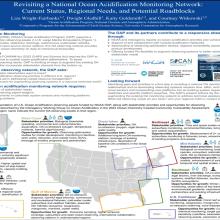Revisiting a National Ocean Acidification Monitoring Network: Current Status and Regional Needs
Elizabeth
Wright-Fairbanks
NOAA Ocean Acidification Program
Poster
Ocean acidification alters the marine carbonate system, creating potential ecological, economic, and cultural risk. Since its founding in 2011, the National Oceanic and Atmospheric Administration’s Ocean Acidification Program (OAP) has been a leader in sponsoring domestic ocean acidification monitoring and observing to inform regional vulnerability assessments, parameterize coastal biogeochemical models, and address stakeholder needs. OAP presently supports an observing network composed of 16 coastal and Great Lakes carbon dioxide buoys, 3 comprehensive ocean acidification research cruises in U.S. Large Marine Ecosystems, a suite of underway systems, a limited number of uncrewed observing systems, and regional stakeholder networks that coordinate local monitoring programs. However, as the audience of and interest in OA science has grown, nation-wide environmental monitoring and observing needs have matured. Complex oceanic processes and federal mandates necessitate advances in observing capabilities, including subsurface and large-scale spatial coverage, the development of multi-parameter sensors, and increased partnership to leverage efforts across sectors. To address these needs, OAP is reimagining a bottom-up approach to ocean observing, in which local science and stakeholder needs are identified and utilized to design regional nodes of a national monitoring network. Roadblocks to this effort include sensor development, platform commercialization, and implementation costs. This poster will address regional OA vulnerabilities and stakeholder needs and the modifications to the ocean observing system that are needed to address those gaps.

Poster file
wright-fairbanks.pdf
(801.01 KB)
